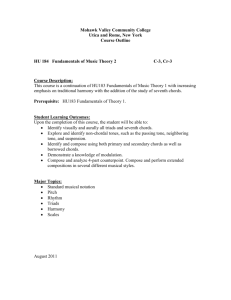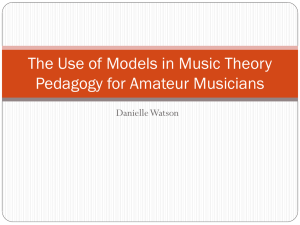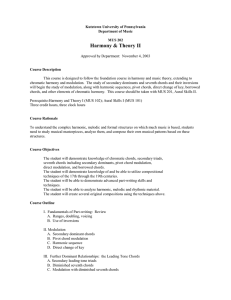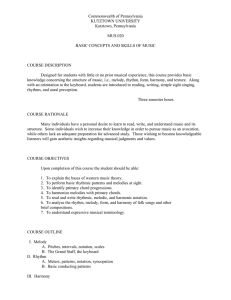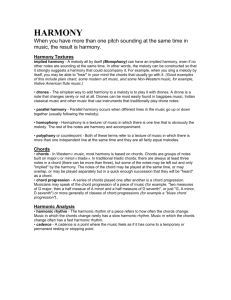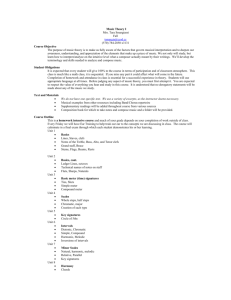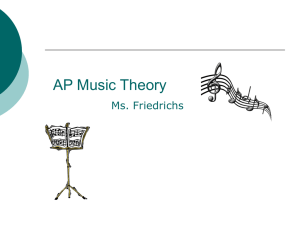Harmony & Theory III
advertisement
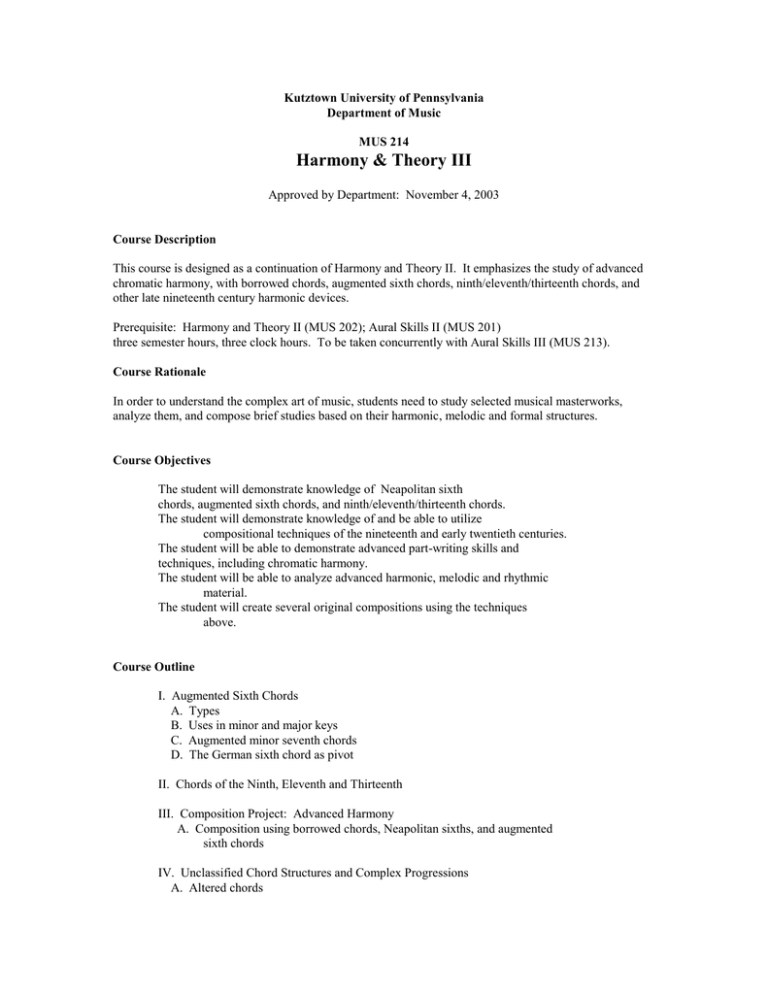
Kutztown University of Pennsylvania Department of Music MUS 214 Harmony & Theory III Approved by Department: November 4, 2003 Course Description This course is designed as a continuation of Harmony and Theory II. It emphasizes the study of advanced chromatic harmony, with borrowed chords, augmented sixth chords, ninth/eleventh/thirteenth chords, and other late nineteenth century harmonic devices. Prerequisite: Harmony and Theory II (MUS 202); Aural Skills II (MUS 201) three semester hours, three clock hours. To be taken concurrently with Aural Skills III (MUS 213). Course Rationale In order to understand the complex art of music, students need to study selected musical masterworks, analyze them, and compose brief studies based on their harmonic, melodic and formal structures. Course Objectives The student will demonstrate knowledge of Neapolitan sixth chords, augmented sixth chords, and ninth/eleventh/thirteenth chords. The student will demonstrate knowledge of and be able to utilize compositional techniques of the nineteenth and early twentieth centuries. The student will be able to demonstrate advanced part-writing skills and techniques, including chromatic harmony. The student will be able to analyze advanced harmonic, melodic and rhythmic material. The student will create several original compositions using the techniques above. Course Outline I. Augmented Sixth Chords A. Types B. Uses in minor and major keys C. Augmented minor seventh chords D. The German sixth chord as pivot II. Chords of the Ninth, Eleventh and Thirteenth III. Composition Project: Advanced Harmony A. Composition using borrowed chords, Neapolitan sixths, and augmented sixth chords IV. Unclassified Chord Structures and Complex Progressions A. Altered chords B. Chord functions produced by sequence and enharmonicism C. Chords produced by change of mode V. The Close of the Nineteenth Century A. Review of traditional harmony B. Triads in chromatic third relationship C. Root movement by tritone D. Evasion of tonic E. Unconventional root movement VI. Advanced Musical Analysis A. Harmonic usage in late nineteenth century music B. Melodic materials C. Rhythmic materials VII. Debussy and Impressionism A. Tonality and cadence structure B. Whole tone pentatonic scales C. Medieval modes D. Harmonic progressions E. Quartal and quintal harmony; added tone chords VII. Introduction to Twentieth Century Music A. Melody B. Meter and rhythm C. Harmony D. Analysis Assessment: Assessment of each student’s level of accomplishment with reference to the course objectives will be based upon the following: I. Regular assignments in analysis and part-writing of chromatic harmony and in twentieth-century compositional styles II. Creative projects and in-class presentations III. Examinations and quizzes Textbook Ottman, Robert W. Advanced Harmony, 5th edition. Upper Saddle River, NJ: Prentice-Hall, 2000. Instructional Resources Benward, Bruce. Music in Theory and Practice, sixth edition. Dubuque, Iowa: William C. Brown Publishers, 1997. DeVoto, Mark, ed. Mostly Short Pieces: an Anthology for Harmonic Analysis. New York: W.W. Norton, 1992. Dorr, Joyce. Introductory Music Theory. Belmont, CA: Wadsworth Publishing Co., 1995. Duckworth, William. A Creative Approach to Music Fundamentals. Belmont, CA: Wadsworth Publishing Co., 1995. Gauldin, Robert. Harmonic Practice in Tonal Music. New York: W.W. Norton and Company, Inc., 1997. Henry, Earl. Fundamentals of Music, second edition. Englewood Cliffs, NJ: Prentice Hall, 1993. Herrold, Rebecca M. Mastering the Fundamentals of Music. Upper Saddle River, NJ: Prentice Hall, 1997. Kamien, Roger, ed. The Norton Scores, fifth edition. New York: W. W. Norton, 1990. Kostka, Stefan and Dorothy Payne. Tonal Harmony, 5th edition. New York: McGraw Hill, 2004. Levy, Ernst. A Theory of Harmony. Albany, NY: Sate University of New York Press, 1985. Manoff, Tom. The Music Kit, third edition. New York: W.W. Norton, 1994. Ottman, Robert W. and Frank D. Mainous. Rudiments of Music. Englewood Cliffs, NJ: Prentice Hall, 1995. Ottman, Robert W. Elementary Harmony, sixth edition. Englewood Cliffs, NJ: Prentice Hall, 1998. Rumery, Kenneth R. Introduction to Musical Design. Dubuque, Iowa: Wm. C. Brown, 1992. Piston, Walter. Harmony, fifth edition. New York: W. W. Norton, 1987. Spencer, Peter. The Practice of Harmony, third edition. Upper Saddle River, NJ: Prentice-Hall, Inc., 1996. Turek, Ralph: Analytical Anthology of Music. New York: McGraw Hill, 1992. White, Gary. Music First, second edition. Dubuque, Iowa: W. C. Brown, 1993.
